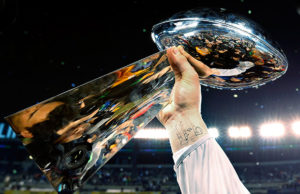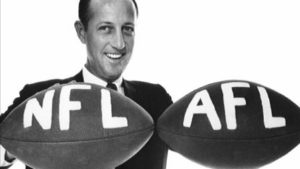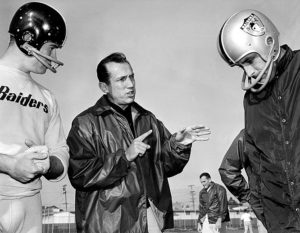Written by Jim Clarke, June 8, 2016, at 4:42 a.m.
On this day 50 years ago, one of the greatest landmark achievements in sports was solidified. On June 8, 1966, the merger uniting the National Football League and American Football league was official. What would follow is a league that captivated the hearts and minds of Americans across the country.
This merger was an important part of history, so much so that many can’t even fathom to think what the state of football and sports as whole would be without it. Now it’s time to take a look back at and appreciate one of the most iconic decisions in the history of sports.
Pro Football’s Roots
The National Football League had been founded in Canton, Ohio in 1920 by a group of men from the same town. Jim Thorpe was the league’s first president, and helped bring in the age of professional football.
A few rival leagues sprung up, but not many ever could compete with the NFL. The AAFC (All-America Football Conference) arose in 1946 and provided a real competitor for the NFL, but due to financial troubles the league went under after just three years. The teams from that league were absorbed into the NFL in 1950, further solidifying the NFL’s spot at the top of all professional football.
The AFL Arrives
In 1959 the son of Texas oil magnate H.L. Hunt, Lamar Hunt wanted to either purchase the (then) Chicago Cardinals and bring them to Dallas or set up his own expansion team for the NFL in Dallas. Unfortunately, the league did not budge and was not looking to expand at that time.
So instead of giving up on his dreams of owning a professional football team, Hunt went another route. He decided to set up his own league to rival the NFL, something no other league had truly come close to doing. This is where the American Football League was born.
The AFL had eight teams at opening day of its new league in the autumn of 1960 and was quickly proving to be great competition for the NFL.
The AFL took steps that the NFL often wouldn’t. The AFL had much more racial diversity, which was somewhat lacking in the NFL, as they were often recruiting from smaller schools as well as predominantly black colleges.
They also introduced a thinner, easier-to-throw football that revolutionized the game and added a new exciting element to the game. The AFL also had a two-point conversion that the NFL did not have. All of these paired with a similar network broadcasting plan to the NFL, and it was clear that the AFL was a very realistic rival to the NFL.
Competition Rises
The NFL originally did not take the AFL very seriously. The NFL was receiving coverage on news programs as well as being favored heavily in publications like Sport Illustrated. AFL scores would often be left off of programs that would show NFL scores, attempting to mitigate the growth of the AFL.
Despite everything, the AFL managed to stay afloat financially. They moved a few teams out of NFL markets and pursued ventures in San Diego and Kansas City. Then AFL struck gold. They landed a 5 year, $36 million contract with NBC for exclusive broadcasting rights to AFL games. This helped to further legitimize the AFL and showed that the NFL actually had something to worry about.
During these years in the early 60’s, the NFL and AFL would often get into bidding wars over college prospects. They would throw massive amounts of money at college stars hoping that they would choose their league over the other.
In Steps Al Davis
There was a sort of unwritten rule amongst the leagues that they would not sign players who were under contract in the rival league. This all changed when the NFL’s New York Giants signed Pete Gogolak, a placekicker who had played out his option in 1965 with the AFL’s Buffalo Bills.
This was a massive breach of trust by the NFL, and the members of the AFL community sought recompense. Al Davis, co-owner of the AFL’s Oakland Raiders, stepped in to settle the score and took over as the AFL commissioner in April 1966. After the Gogolak transfer to the New York Giants, Al Davis started signing big name players from NFL teams, such as Mike Ditka and John Brodie.
This controversy ultimately sparked negotiations between the leagues to merge into one.
Al Davis’ take-no-prisoners attitude intimidated the NFL and made them realize that the AFL was out for blood. They didn’t just want to co-exist. They wanted to sink the NFL. So the NFL opened up negotiations to merge into one, mostly out of fear. Davis was hesitant at first, but overall saw the mutually beneficial potential that merging the leagues presented.
AFL-NFL Merger
Then on June 8, 1966, the merger was finalized.
The two leagues remained separate, if only in spirit now then fiscally, only playing teams from their respective leagues until the time came for them to crown a champion in the AFL-NFL World Championship Games, which came to be known as the Super Bowl in January of 1967.
The two leagues officially merged in 1970, and the organization and meaning of the National Football League were now forever morphed. The leagues were now known as the American Football Conference (AFC) and the National Football Conference (NFC) and teams from one conference would play a few teams from the other’s conference during the regular season.
The agreement was that all franchises, teams, and players from the AFL would be retained, but the name and logo would be retired. Add a couple more expansion franchises over the years, and this is the National Football League we all know and love today.
50 Great Years
The NFL has provided lasting memories for generations of Americans. From the early years of Bart Starr and Vince Lombardi, to the Steel Curtain Steelers, to the New England Patriots of the modern era and many more in between. This sport is an American treasure and one of the greatest sources of excitement on the planet.
So on this day, I and many others extend our gratitude to the people responsible for helping the NFL become a reality. Football has brought my family closer, helped me meet wonderful people, made Monday morning conversations fun, and has contributed to some of the greatest memories in my entire life. Without this merger, there’s no telling what could have been.
So here’s to the NFL, and to 50 more great years filled with long-lasting and joyous memories. What are your best memories of the last 50 years of NFL Football?


